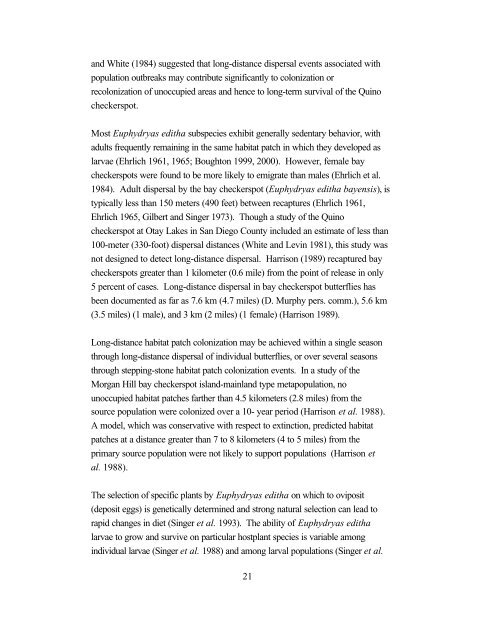Outline of Quino Recovery Plan - The Xerces Society
Outline of Quino Recovery Plan - The Xerces Society
Outline of Quino Recovery Plan - The Xerces Society
You also want an ePaper? Increase the reach of your titles
YUMPU automatically turns print PDFs into web optimized ePapers that Google loves.
and White (1984) suggested that long-distance dispersal events associated with<br />
population outbreaks may contribute significantly to colonization or<br />
recolonization <strong>of</strong> unoccupied areas and hence to long-term survival <strong>of</strong> the <strong>Quino</strong><br />
checkerspot.<br />
Most Euphydryas editha subspecies exhibit generally sedentary behavior, with<br />
adults frequently remaining in the same habitat patch in which they developed as<br />
larvae (Ehrlich 1961, 1965; Boughton 1999, 2000). However, female bay<br />
checkerspots were found to be more likely to emigrate than males (Ehrlich et al.<br />
1984). Adult dispersal by the bay checkerspot (Euphydryas editha bayensis), is<br />
typically less than 150 meters (490 feet) between recaptures (Ehrlich 1961,<br />
Ehrlich 1965, Gilbert and Singer 1973). Though a study <strong>of</strong> the <strong>Quino</strong><br />
checkerspot at Otay Lakes in San Diego County included an estimate <strong>of</strong> less than<br />
100-meter (330-foot) dispersal distances (White and Levin 1981), this study was<br />
not designed to detect long-distance dispersal. Harrison (1989) recaptured bay<br />
checkerspots greater than 1 kilometer (0.6 mile) from the point <strong>of</strong> release in only<br />
5 percent <strong>of</strong> cases. Long-distance dispersal in bay checkerspot butterflies has<br />
been documented as far as 7.6 km (4.7 miles) (D. Murphy pers. comm.), 5.6 km<br />
(3.5 miles) (1 male), and 3 km (2 miles) (1 female) (Harrison 1989).<br />
Long-distance habitat patch colonization may be achieved within a single season<br />
through long-distance dispersal <strong>of</strong> individual butterflies, or over several seasons<br />
through stepping-stone habitat patch colonization events. In a study <strong>of</strong> the<br />
Morgan Hill bay checkerspot island-mainland type metapopulation, no<br />
unoccupied habitat patches farther than 4.5 kilometers (2.8 miles) from the<br />
source population were colonized over a 10- year period (Harrison et al. 1988).<br />
A model, which was conservative with respect to extinction, predicted habitat<br />
patches at a distance greater than 7 to 8 kilometers (4 to 5 miles) from the<br />
primary source population were not likely to support populations (Harrison et<br />
al. 1988).<br />
<strong>The</strong> selection <strong>of</strong> specific plants by Euphydryas editha on which to oviposit<br />
(deposit eggs) is genetically determined and strong natural selection can lead to<br />
rapid changes in diet (Singer et al. 1993). <strong>The</strong> ability <strong>of</strong> Euphydryas editha<br />
larvae to grow and survive on particular hostplant species is variable among<br />
individual larvae (Singer et al. 1988) and among larval populations (Singer et al.<br />
21
















